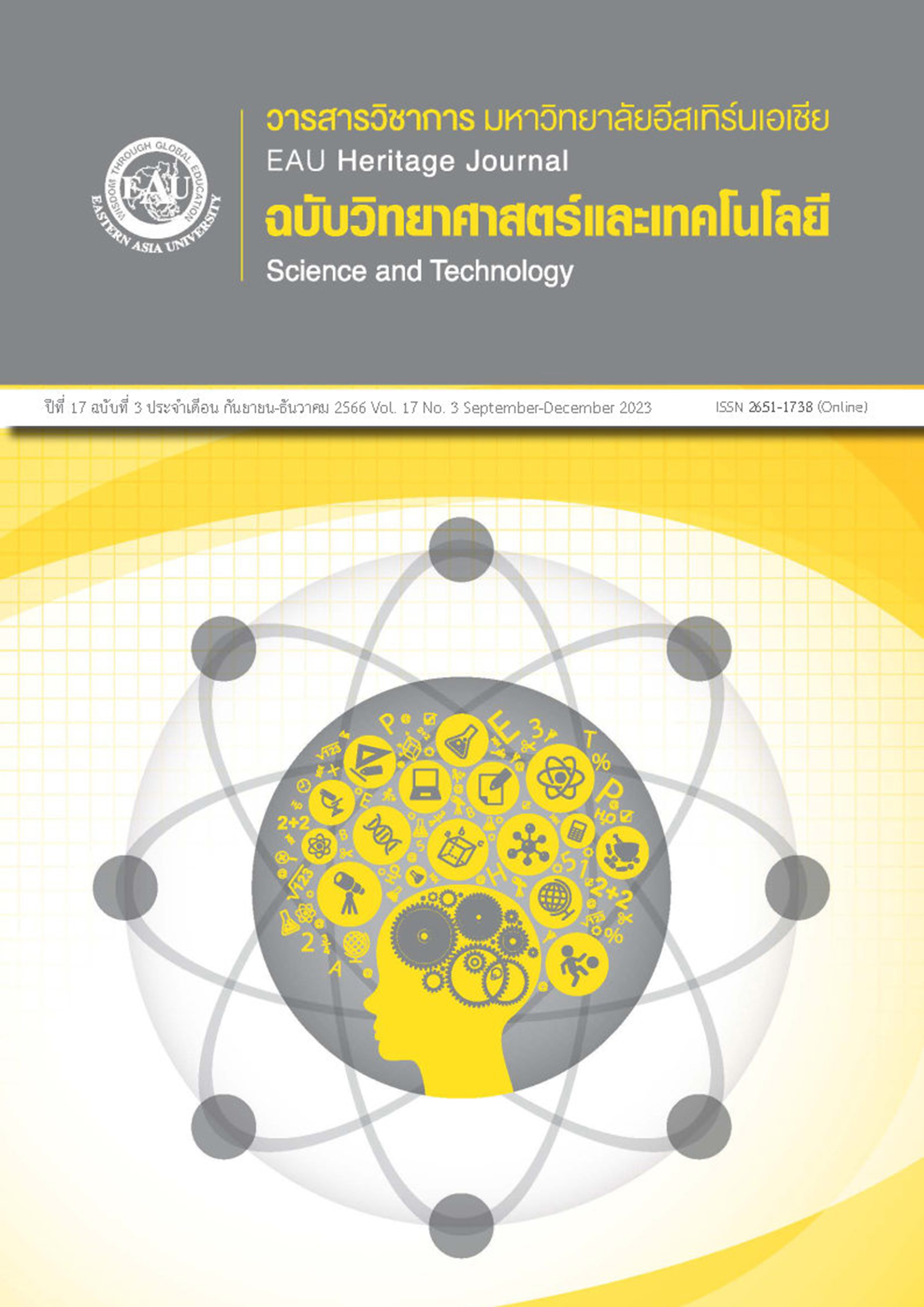การคัดเลือกโครงการ Fast Travel เพื่อการตัดสินใจของ ผู้บริหารท่าอากาศยานนานาชาติหาดใหญ่
คำสำคัญ:
self-service technology, prioritization, analytic hierarchy process, airportบทคัดย่อ
การวิจัยครั้งนี้เป็นการวิจัยเชิงปริมาณ มีวัตถุประสงค์เพื่อ (1) ศึกษาเกณฑ์ที่มีผลต่อการตัดสินใจที่ใช้ในการคัดเลือกโครงการ Fast Travel เพื่อการตัดสินใจของผู้บริหารท่าอากาศยานนานาชาติหาดใหญ่ และ (2) จัดลำดับความสำคัญของโครงการ Fast Travel เพื่อการตัดสินใจของผู้บริหารท่าอากาศยานนานาชาติหาดใหญ่ภายใต้หลายเกณฑ์ โดยการวิจัยนี้เป็นวิจัยเชิงปริมาณ สำหรับกลุ่มตัวอย่างสำหรับการวิจัย จำนวน 36 คน ซึ่งประกอบด้วย (1) ผู้บริหารเกี่ยวข้องกับด้านการให้บริการผู้โดยสารในกระบวนการเดินทางของผู้โดยสาร ณ ท่าอากาศยานนานาชาติหาดใหญ่ จำนวน 5 คน และ (2) ผู้ปฏิบัติงานที่เกี่ยวข้องกับด้านการให้บริการผู้โดยสาร ในกระบวนการเดินทางของผู้โดยสาร ณ ท่าอากาศยานนานาชาติหาดใหญ่ จำนวน 31 คน โดยใช้การสุ่มตัวอย่างแบบแบ่งชั้นภูมิ เครื่องมือที่ใช้ในการเก็บรวบรวมข้อมูล คือ แบบสอบถาม สำหรับการวิเคราะห์ข้อมูลในงานวิจัยครั้งนี้ คือ สถิติพรรณนา สถิติอนุมาน และใช้เทคนิคกระบวนการลำดับชั้นเชิงวิเคราะห์ผลการศึกษาพบว่า เกณฑ์หลักที่ใช้ในการจัดลำดับความสำคัญมี 5 ด้าน คือ ด้านสมรรถนะทางเทคโนโลยี ด้านเทคนิค ด้านความเสี่ยง ด้านการเงิน และด้านผลกระทบทางธุรกิจ และเกณฑ์รองจำนวน 16 เกณฑ์ สำหรับเทคโนโลยีการให้บริการตนเองของโครงการ Fast Travel ที่มีความสำคัญอันดับแรก และควรได้รับการพัฒนาหรือนำมาใช้ก่อน คือ “การเช็คอินด้วยตนเอง” โดยมีน้ำหนักความสำคัญรวมเท่ากับ 0.262
เอกสารอ้างอิง
Airports of Thailand Public Co.,Ltd. (2020). Annual report 2020. Retrieved from https://corporate.airportthai.co.th/wp-content/uploads/2021/01/AnnualReport2020th.pdf (in Thai)
Angsuchoti, S. (n.d.). Analyzing relationships between variables technique. Retrieved from https://www.stou.ac.th/offices/ore/info/cae/uploads/pdf/636366560441132172.pdf (in Thai)
Aumnuaiworachai, A., Huangsuwan, S., & Noitonglek, K. (2022). Prioritization of factors affecting safety management efficiency of employee’s work at Chiang Mai International Airport. EAU Heritage Journal Science and Technology, 16(3), 92–103. (in Thai)
Coldrick, S., Longhurst, P., Ivey, P., & Hannis, J. (2005). An R&D options selection model for investment decisions. Technovation, 25(3), 185–193. doi: 10.1016/s0166-4972(03)00099-3
Demirtaş, N., Özgürler, Ş., Özgürler, M., & Güneri, A. F. (2014). Selecting e-purse smart card technology via Fuzzy AHP and ANP. Journal of Applied Mathematics, 2014(4), 1–14. doi: 10.1155/2014/619030.
Forthofer, Ronald N., Lee, Eun Sul., & Hermandez, M. (2007). Biostatistics: A Guide to Design, Analysis, and Discovery (2nd ed.). California: Elsevier Academic Press.
Gures, N., Inan, H., & Arslan, S. (2018). Assessing the self-service technology usage of Y-Generation in airline services. Journal of Air Transport Management, 71(1), 215–219. doi: 10.1016/j.jairtraman.2018.04.008
Hanine, M., Boutkhoum, O., Tikniouine , A., & Agouti, T. (2016). Application of an integrated multi-criteria decision making AHP-TOPSIS methodology for ETL software selection. SpringerPlus, 5(263), 1-17.
Habib, M., Khan, R., & Piracha, J. L. (2009). Analytic network process applied to R&D project selection. 2009 International Conference on Information and Communication Technologies, 131(4), 274–280. doi: 10.1109/icict.2009.5267179
IATA. (2015). The IATA simplifying the business (StB) fast travel program. Montreal: Hugh Best.
IATA. (2015). Overcoming hurdles as Fast Travel moves forward apace. Retrieved from https://airlines.iata.org/2015/06/03/overcoming-hurdles-fast-travel-moves-forward-apace
IATA. (2016). Passenger processing: The benefits of fast travel. Retrieved from https://www.internationalairportreview.com/article/23211/passenger-processing-benefits-fast-travel/
Komlan, G., Koffi, D., & Kingsford, K. M. (2016). MCDM technique to evaluating mobile banking adoption in the togolese banking industry based on the perceived value: perceived benefit and perceived sacrifice factors. International Journal of Data Mining & Knowledge Management Process, 6(3), 37-56. doi: 10.5121/ijdkp.2016.6304
Lawson, C. P., Longhurst, P. J., & Ivey, P. C. (2006). The application of a new research and development project selection model in SMEs. Technovation, 26(2), 242–250. doi: 10.1016/j.technovation.2004.07.017
Meade, L. M., & Presley, A. (2002). R&D project selection using the analytic network process. IEEE Transactions on Engineering Management, 49(1), 59–66. doi: 10.1109/17.985748.
Mohanty, R. P., Agarwal, R., Choudhury, A. K., & Tiwari, M. K. (2005). A fuzzy ANP-based approach to R&D project selection: A case study. International Journal of Production Research, 43(24), 5199–5216. doi: 10.1080/00207540500219031
Mozaffari, M. M., Piri, M., & Memarzade, M. (2012). Optimize technology selection using Fuzzy Delphi, Fuzzy AHP, and SIR.VIKOR. American Journal of Scientific Research, 55(2012), 23-41. https://bit.ly/41rRcYc
Natarajan, T., Arasu, B. S., & Manickavasagam, S. (2010). Customer’s choice amongst Self Service Technology (SST) channels in retail banking: A study using Analytical Hierarchy Process (AHP). Journal of Internet Banking and Commerce, 15(2), 1-16. https://bit.ly/41j18Tw
Rajak, M., & Shaw, K. (2019). Evaluation and selection of mobile health (mHealth) applications using AHP and fuzzy TOPSIS. Technology in Society, 59(11), 1-7. doi: 10.1016/j.techsoc.2019.101186
Saaty, T. (1980). The analytical hierarchy process. McGraw Hill: New York.
Shen, Y.-C., Chang, S.-H., Lin, G. T. R., & Yu, H.-C. (2010). A hybrid selection model for emerging technology. Technological Forecasting and Social Change, 77(1), 151–166. doi: 10.1016/j.techfore.2009.05.001
Si, J., Marjanovic-Halburd, L., Nasiri, F., & Bell, S. (2016). Assessment of building-integrated green technologies: A review and case study on applications of Multi-Criteria Decision Making (MCDM) method. Sustainable Cities and Society, 27(1), 106–115. doi: 10.1016/j.scs.2016.06.013
Staub, S., & Teber, S. (2015). Turkish air passenger characteristics and approach to self service applications provided by Turkish air transport corporations. Social and Behavioral Sciences, 195 (2015), 32–41. doi: 10.1016/j.sbspro.2015.06.168
Tansirikhongkon, V. (2014). AHP Advanced decision making for organizational advancement and public well-being. Bangkok: Chulalongkorn University Book Center. (in Thai)
Thailand Airport Hub. (2021). Hat Yai Airport. Retrieved from http://hatyai.thailandairportshub.com/th/category-view/airport-information (in Thai)
Titichattawong, R. (2014). Prioritizing key importance factor for machine selection by analytic hierarchy process: A case study of jewelry factory (Master’s thesis). Rajamangala University of Technology Thanyaburi, Pathum Thani. (in Thai)
Wongchaipawatt, P., & Theeranuphattana, A. (2015). Selection of cloud computing providers at Chiang Mai University by applying analytical hierarchy process. AccBA Journal, 1(3), 427–439. (in Thai)
Wonghiriwat, K., & Suthammasapa, J. (2008). The application of AHP techniques to priortized of criteria and selected software for Government Housing Bank (Master’s thesis). Sukhothai Thammathirat Open University, Nonthaburi. (in Thai)
Xu, W. X., Xu, L., Liu, X. M., & Jones, J. D. (2008). A new approach to decision-making with key constraint and its application in enterprise information systems. Enterprise Information Systems, 2(3), 287–308. doi: 10.1080/17517570802302341.
Yamane, T. (1973). Statistics: An introductory analysis (3rd ed.). New York: Harper and Row Publications.
Zhang, J., Daim, T. U., Choi, B., & Phan, K. (2008). A multiple perspective model for technology assessment. Journal of Technology Management in China, 3(3), 264–278. doi: 10.1108/17468770810916177







